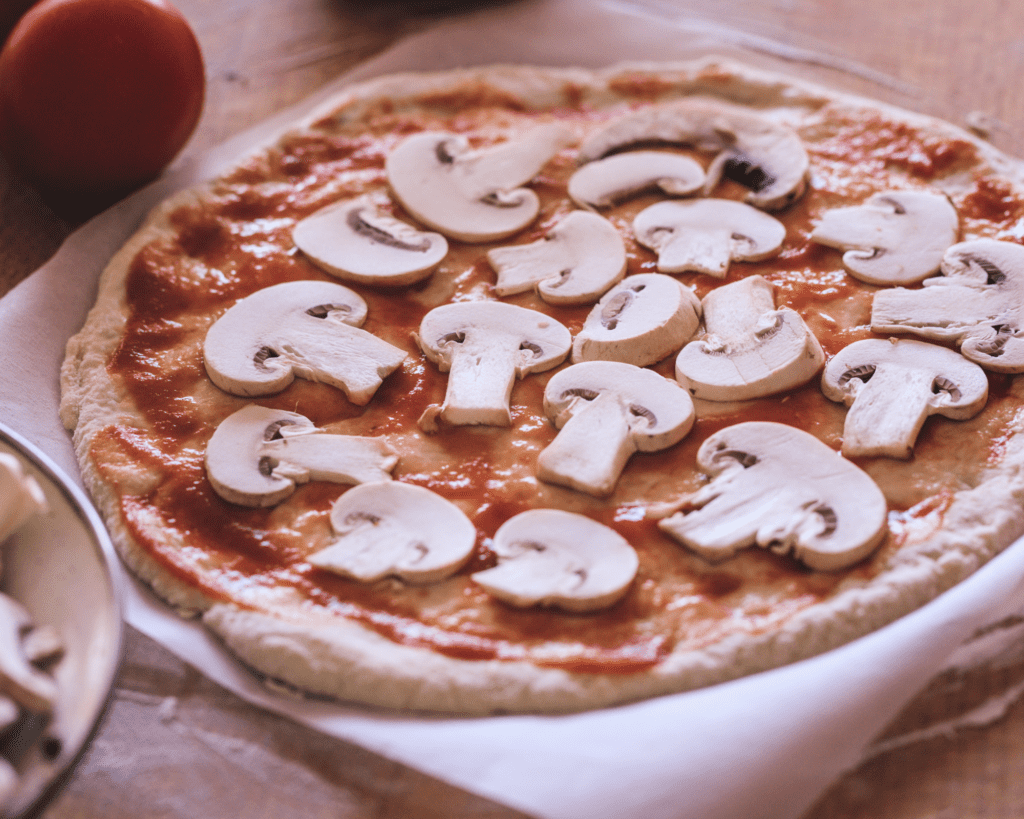There are so many delicious ways to top a pizza, but how do you know which toppings pair well together? In this guide, I’ll show you how to layer your toppings for the perfect pizza every time.
So, how do you layer pizza toppings? The best way to layer your pizza toppings is by starting with the sauce, then adding your cheeses, followed by your meats and vegetables. Some people like to add their meats and vegetables first, before topping with cheese. However, this can often lead to the vegetables becoming overcooked and dried out by the time the cheese is fully melted.
Sauce first, then cheese, then meats and vegetables is a much better way to go.

In this post, we’ll go over the specifics of how to properly layer a pizza to get the most out of your toppings. It matters just as much where you put each topping as what toppings you choose.
Whether you’re cooking in a pan or a brick oven, you need to know how to layer your toppings. Whether you’re looking for a classic combination or something more adventurous, these tips will help you create the perfect pie.
The Correct Order to Properly Layer a Pizza
The most crucial detail in properly layering a pizza to get the best texture and flavour from your toppings is what precise order you place them. Obviously, to get the most out of cheese, you want it largely exposed so it gets nice and toasted, which can bring out more of its divine flavour.
Proper layering can also help ensure that your pizza doesn’t get stuck to the stone and that you don’t end up having to do a lot of work to clean your pizza stone.
While it may not be important to you, it’s certainly ranked in our household: presentation matters. Adding the best looking and most appetizing toppings last so they can be seen makes a huge difference. I don’t know if you’re aware, but our minds have a way of deceiving us into thinking something often looks better than it is, and some of that internal lie is what often sells us on food. So take advantage of it and pull one over on your guests.

It’s not that you’re making bad pizza, mind you. It’s just a mental reaction. More importantly than how it looks, though, is the texture. The last thing anyone wants is a sickly, mushy pizza that just carelessly mixes flavors.
This is why the heavier toppings, such as pepperoni or large mushrooms, should always go on top. Otherwise, the pizza just gets soggy. Ingredients under the cheese get steamed and cooked very quickly. The heat releases water vapors, which causes them to steam.
If you have pineapple, a particularly controversial topping, never put it under the cheese. Any topping you expect to be crisp is best left above the cheese.
The other option, of course, is to cook the toppings beforehand, which can definitely ensure they’ll be crispy. However it can be time consuming, and if you’re not careful, it can lead to overcooking.
The final issue comes down to ease of eating. Is a guest going to take a bite and have everything fall all over their clothes or, preferably, on the plate? This is something you need to consider, as there’s nothing that’ll upset a dinner party more than a disastrous meal.

What Goes Under The Cheese?
There are some ingredients that work better under the cheese, however you want to keep them small. If, for instance, you have tiny bits of onion, cooked or uncooked, they can add a nice, surprising zest to your pizza if they’re hidden underneath a load of cheese and other toppings.
Any peppers or spicy toppings can rest under the cheese as well. Any toppings that are particularly sensitive to dry, hot temperatures would better serve their purpose under the cheese.
Putting the Cheese On First
There are some occasions where it’s actually appropriate to put the cheese on before anything else. This Sicilian style can be commonly found in parts of New York and Chicago, and it sounds a little wild, but it’s surprisingly satisfying.
The theory behind this is that the crust cooks better when not exposed directly to Marinara sauce. It makes sense, as the dough does absorb the sauce, making it soggier. I can’t say it’s better, but it’s certainly different than what I’m used to. It’s definitely worth trying, at least once.
Putting a water-proof layer of sliced cheese before the sauce is always an option as well.
However you choose to dress your pizza, the most important thing is that your guests are satisfied. And that involves a bit of everything – from presentation to texture and taste. If you’re confident enough that you’re dressing your pizza the way it’s meant to be served, then you’re probably right.